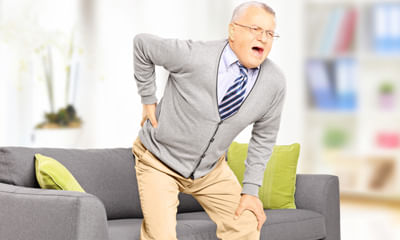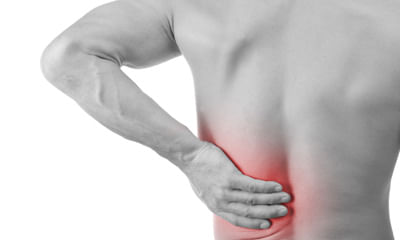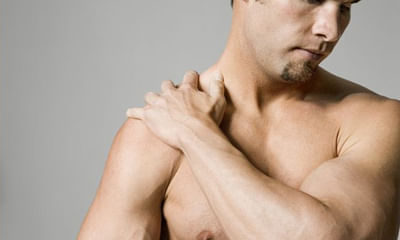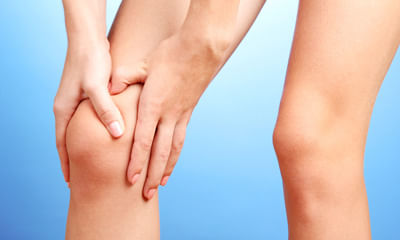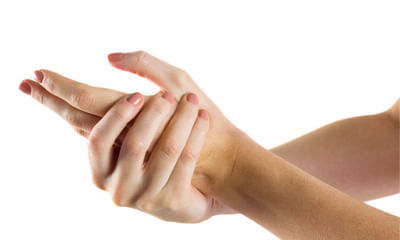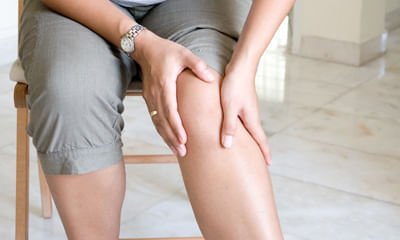Frozen Shoulder Causes
I am 23 years old l. I have lower back pain from 1 year. And recently my shoulders are uneven from 2 months. I go to gym ...
Ask Free Question
Sit on an upright bench, like one you'd use for a shoulder press. Holding a dumbbell in your right hand, place your left hand under your left butt cheek and grab the side of the seat. Let your right hand hang down straight by your side and pull your shoulder blades back and together. Now raise your right shoulder up towards your ear-raise it straight up instead of rolling yourshoulder. Hold for a beat at the top, and then return to the start position. Complete a set of 10, and repeat on the other side. Knee pain. If you are overweight, losing weight will also help to reduce pressure on your knee.•mobility exercises rest. Avoid doing things that require you to bend at the hip or put a lot of pressure on the hip. Avoid sleeping on the side of your hip that is painful and sitting for long periods of time •cold and heat. Treating pain with heat and cold may help. Wrap an ice pack or a bag of frozen vegetables in a towel to ice your hip. A warm bath or shower may also help reduce your pain and prepare your muscles for stretching. •stretch. Gently stretching your body may reduce hip pain, especially if the cause is a strain or pinched nerve.
I am not pregnant but I am doubting as menopause because my age is 47 and for past one month I am experiencing frozen sh ...
Ask Free Question
Frozen shoulder pain which is related to menopause- not necessarily check up with gynecologist and if required blood test serum fsh to confirm.
Asalamu alaikum Dr. shab 2 year ago I was pruning my orchard my right hand got tired I use my left hand unfortunately my ...
Ask Free Question
•mobility exercises rest. Avoid doing things that require you to bend at the hip or put a lot of pressure on the hip. Avoid sleeping on the side of your hip that is painful and sitting for long periods of time •cold and heat. Treating pain with heat and cold may help. Wrap an ice pack or a bag of frozen vegetables in a towel to ice your hip. A warm bath or shower may also help reduce your pain and prepare your muscles for stretching. •stretch. Gently stretching your body may reduce hip pain, especially if the cause is a strain or pinched nerve. 1. Knee lift1.Lie on the back, extending both legs flat along the floor. 2.Keeping the left leg straight, pull the right knee up toward the chest. 3.Place both hands on top of the knee to help pull it in toward the chest. 4.Hold the stretch for 10 seconds. 5.Let go of the knee and gently lower the leg back toward the floor. 6.Repeat this exercise 5–10 times on each knee. 2.double hip rotation 1.Lie flat on the back. Then, bend the knees and bring them toward the body until the feet are flat on the floor. 2.Gently rotate the knees to the left, lowering them toward the floor. Rotate the head to face the right while keeping the shoulders against the floor. 3.Hold this position for 20–30 seconds. 4.Slowly return both the head and knees to the starting position. 5.Repeat on the opposite side. 3.bridging 1.Lie on the back, bending both legs at the knee and placing the feet flat on the floor. Keep the arms by the sides of the body with the palms facing downward. If necessary, place a small pillow underneath the neck and head for support. 2.Slowly lift the pelvis and lower back upward. Be sure to keep the shoulders and upper body on the floor. 3.Hold the position for 5 seconds. 4.Gradually lower the back and pelvis toward the floor, starting at the top of the spine. Roll down through the spine until the entire back is flat against the floor again. 5.Repeat this exercise 5–10 times. 4.butterfly stretch 1.Sit on the ground, bend your legs, and bring the soles of your feet together so they touch, letting your knees fall out to the sides. 2.Bring your heels as close to your body as you can and lean forward into the stretch, using your elbows to gently push your knees toward the ground. 5.side lying leg raise 1.Lay on your right side with your legs straight and stacked on top of each other, propping yourself up with your elbow. If you’re using an exercise band, position it just above your knees. 2.Keeping your hips stacked, engage your core and lift your left leg straight up as far as you can. Slowly lower back down. Repeat on other side. 6.hip flexion 1.Stand upright. 2.Extend one arm out to the side and hold on to a sturdy surface, such as a wall, table, or chair, for support. 3.Slowly raise the right knee to the level of the hip or as far as is comfortable while keeping the left leg straight. 4.Only hold this position for a second before placing the left foot back on the floor. 5.Repeat with the left knee. 6.Do 5–10 repetitions of this exercise. 7.hip extension 1.Stand upright with the legs straight and the feet shoulder-width apart. 2.Extend both arms out in front and hold on to a chair, table, or wall for support. 3.Keeping the right leg straight, lift the left leg backward without bending the knee. 4.Lift the leg as far as possible without causing discomfort, then clench the buttock tightly and hold the position for 5 seconds. Repeat this stretch 5–10 times on each leg. To increase the resistance, try attaching small weights to the legs. 8.hip abduction 1.Stand upright. 2.Extend the left arm out to the side and hold on to something solid, such as a chair, table, or wall. 3.Starting with the feet together, lift the right leg out to the right side. Keep the left leg straight and avoid rotating the hips. 4.Hold the position for 5 seconds and then slowly return the leg to the starting position. Do this exercise 5–10 times on one leg, then repeat it on the other side.
I am 45 years old height 5'8" weight about 81 kg. Am having frozen shoulder in right shoulder. Can anti inflammatory inj ...
Ask Free Question
Do’s and don’ts for shoulder pain do’s do the prescribed exercise regularly to maintain strength, flexibility and range of motion. Do keep the affected arm supported. Use an ice pack for pain relief. Apply the ice pack 3-4 times a day for 10 minutes. Don’ts don't sleep on the affected side. Don't lift heavyweight with the affected arm. Don't jerk your shoulder to avoid stress. Don't use the arm to push yourself up in bed or from a chair. Don't participate in contact sports or do any repetitive heavy lifting. We suggest you to wear shoulder support brace which is available in two different sizes which makes the patient to feel comfortable as it maintains the shoulder in anatomical position and the short lever is maintained. The reason to maintain the short lever in the shoulder joint is it helps the shoulder to prevent the movements which itself is the key to have better progression of healing in the shoulder region. This is suggested for the following conditions. This shoulder support brace what we are suggesting for you is available at our clinic. If you want you can buy from us, if you are far away from chennai we can send you by courier. The reason why we are conveying you to buy from us is we can demonstrate over the videocall (using whatsapp) and also we can monitor you throughout when to wear it and how long to wear it. And also if you find any difficulty wearing the brace you can also revert back to us for few more suggestions and we can propose you good solution how to go about it. Strenghtening exercises 1.pendulum stretch do this exercise first. Relax your shoulders. Stand and lean over slightly, allowing the affected arm to hang down. Swing the arm in a small circle — about a foot in diameter. Perform 10 revolutions in each direction, once a day. As your symptoms improve, increase the diameter of your swing, but never force it. When you're ready for more, increase the stretch by holding a light weight (three to five pounds) in the swinging arm. 2. Towel stretch hold one end of a three-foot-long towel behind your back and grab the opposite end with your other hand. Hold the towel in a horizontal position. Use your good arm to pull the affected arm upward to stretch it. You can also do an advanced version of this exercise with the towel draped over your good shoulder. Hold the bottom of the towel with the affected arm and pull it toward the lower back with the unaffected arm. Do this 10 to 20 times a day. 3. Finger walk face a wall three-quarters of an arm's length away. Reach out and touch the wall at waist level with the fingertips of the affected arm. With your elbow slightly bent, slowly walk your fingers up the wall, spider-like, until you've raised your arm as far as you comfortably can. Your fingers should be doing the work, not your shoulder muscles. Slowly lower the arm (with the help of the good arm, if necessary) and repeat. Perform this exercise 10 to 20 times a day. 4. Cross-body reachsit or stand. Use your good arm to lift your affected arm at the elbow, and bring it up and across your body, exerting gentle pressure to stretch the shoulder. Hold the stretch for 15 to 20 seconds. Do this 10 to 20 times per day. 5. Armpit stretch using your good arm, lift the affected arm onto a shelf about breast-high. Gently bend your knees, opening up the armpit. Deepen your knee bend slightly, gently stretching the armpit, and then straighten. With each knee bend, stretch a little further, but don't force it. Do this 10 to 20 times each day. Starting to strengthen as your range of motion improves, add rotator cuff–strengthening exercises. Be sure to warm up your shoulder and do your stretching exercises before you perform strengthening exercises. 6. Outward rotationhold a rubber exercise band between your hands with your elbows at a 90-degree angle close to your sides. Rotate the lower part of the affected arm outward two or three inches and hold for five seconds. Repeat 10 to 15 times, once a day. 7. Inward rotation stand next to a closed door, and hook one end of a rubber exercise band around the doorknob. Hold the other end with the hand of the affected arm, holding your elbow at a 90-degree angle. Pull the band toward your body two or three inches and hold for five seconds. Repeat 10 to 15 times, once a day. Shoulder exercises and stretches regular exercises and stretches can keep your shoulder strong and flexible. A few things to remember before swinging in to exercises: •stop any exercise if you have more shoulder pain. It may be too soon for you to try. •watch your form. Exercising incorrectly can also cause or worsen shoulder problems. •warm up, even before deep stretching. Light shoulder rolls, gentle movements, or even a warm shower are all ways to warm up your muscles before exercise and stretching. Pendulum stretch for range of motion•stand and bend at the waist. •let your arm on the injured side hang straight down. •keep your neck relaxed. •move your arm in a circle up to 20 times. •do once or more times in a day. Overhead shoulder stretch•sit or stand to do this shoulder stretch. •intertwine your fingers in front of you. •bend your elbows and raise your arms above your head. You can also place your hands on your head or behind it. •gently squeeze your shoulder blades together to move your elbows back. •continue for up to 20 repetitions. Repeat 5 to 10 times a day.Pa shoulder: do’s: •exercise regularly and immediately follow a physical therapy program. •use an ice pack for pain relief. Apply the ice pack 3-4 times a day for 10 minutes. •take pain relievers as directed by your shoulder doctor. Don’ts: •don’t stop moving your shoulders entirely because of the pain. •do not do activities that involve sudden movements, such as heavy lifting on the affected side. As your body recovers, continue to make gentle movements, but avoid irritating and moving your shoulders. •doesn’t sleep on a sore shoulder •don’t miss your workout routine and physical therapy. •don’t neglect your diet. Frozen shoulder is associated with general health. Frozen shoulder is strongly associated with many low-grade systemic inflammatory conditions. Your body needs healthy, anti-inflammatory food to recover. •stop smoking and drinking alcohol. No it will definitely help you to come out of pain. You can consume preferably one tablet per day and not more than that. Drink lot of hot water during your cycle time as there might be gastric trouble during menstrual cycle. We cannot give suggestions about homeopathy medicine as we are physiotherapists. I have given the following suggestions and protocols for your other pain in the back, heel and shoulder.
Doctor my mother has osteoarthritis is it curable its in initial stage is it curable and may I know how long it takes to ...
Ask Free Question
Symptoms of arthritis symptoms of osteoarthritis may include joint pain and progressive stiffness that develops gradually. Symptoms of may include painful swelling, inflammation, and stiffness in the fingers, arms, legs, and wrists occurring in the same joints on both sides of the body, especially upon waking up in the morning. Knee arthritis can be painful and debilitating. For osteoarthritis (oa) of the knee, self-care early on can often help significantly. It is important to stretch and strengthen the surrounding leg muscles to provide more support and reduce stresses around the joint. The following best bet exercises will help you get started on your path to feeling stronger, more flexible and more active. Remember: exercise should not be painful – if you experience pain, discontinue and consult with your physician. Advice: 1.must take adequate rest 2.apply hot water with mild heat with cotton towel 3.avoid cross leg sitting and long time standing 4. Put the small size chair under the ankle during sitting in the chair for leg elevation 5.do the exercise given below 2 times per day 1.quadriceps setting exercise helps to strengthen the quadriceps muscle (the big muscle on the front of the thigh), an important stabilizer of the knee. Lie on your back with the leg you want to exercise straight. Place a small rolled towel underneath the knee. Slowly tighten the muscle on top of the thigh (quadriceps) and push the back of the knee down into the rolled towel. Hold contraction for 5 seconds and then slowly release, resting 5 seconds between each contraction. Perform 3 sets of 10 repetitions, 1 time daily. 2.straight leg raise also helps to strengthen the quadriceps muscle. Lie on your back with the leg you want to exercise straight. The other knee should be bent to support your lower back. Tighten the muscle on the top of your thigh and lift to the level of your other knee. Slowly lower. Perform 3 sets of 10 repetitions, 1 time daily. Knee pain •patellar tendinitis: •risk factor •a combination of factors may contribute to the development of patellar tendinitis, including: •physical activity. •running and jumping are most commonly associated with patellar tendinitis. Sudden increases in how hard or how often you engage in the activity also add stress to the tendon, as can changing your running shoes. •tight leg muscles. Tight thigh muscles (quadriceps) and hamstrings, which run up the back of your thighs, can increase strain on your patellar tendon. •muscular imbalance. •if some muscles in your legs are much stronger than others, the stronger muscles could pull harder on your patellar tendon. This uneven pull could cause tendinitis. •chronic illness. •some illnesses disrupt blood flow to the knee, which weakens the tendon. Examples include kidney failure, autoimmune diseases such as lupus or rheumatoid arthritis and metabolic diseases such as diabetes. •complications •if you try to work through your pain, ignoring your body's warning signs, you could cause increasingly larger tears in the patellar tendon. Knee pain and reduced function can persist if you don't tend to the problem, and you may progress to the more serious patellar tendinopathy. •prevention •to reduce your risk of developing patellar tendinitis, take these steps: •don't play through pain. As soon as you notice exercise-related knee pain, ice the area and rest. Until your knee is pain-free, avoid activities that put stress on your patellar tendon. •strengthen your muscles. Strong thigh muscles are better able to handle the stresses that can cause patellar tendinitis. Eccentric exercises, which involve lowering your leg very slowly after extending your knee, are particularly helpful. •improve your technique. To be sure you're using your body correctly, consider taking lessons or getting professional instructions when starting a new sport or using exercise equipment. •therapy •a variety of physical therapy techniques can help reduce the symptoms associated with patellar tendinitis, including: •patellar tendon strap. A strap that applies pressure to your patellar tendon can help to distribute force away from the tendon and direct it through the strap instead. This may help relieve pain. •iontophoresis. This therapy involves spreading a corticosteroid medicine on your skin and then using a device that delivers a low electrical charge to push the medication through your skin. •platelet-rich plasma injection. This type of injection has been tried in some people with chronic patellar tendon problems. Studies are ongoing. It is hoped the injections might promote new tissue formation and help heal tendon damage. •probably your stamina would've gone down due to over use of the joints and the metabolic activity is more due to running. You need to consume good protein diet so that your body will act as a reservoir. It will help you to fight against rather than affecting one particular area of your body for eg. Knee joint. For knee ligament pain or inflammation you need to keep ice which will help you to prevent the inflammation progressing further. •patellofemoral pain syndrome •usually fully relieved with simple measures or physical therapy. It may recur, however, if you do not make adjustments to your training routine or activity level. It is essential to maintain appropriate conditioning of the muscles around the knee, particularly the quadriceps and the hamstrings. •there are additional steps that you can take to prevent recurrence of patellofemoral •they include: •wearing shoes appropriate to your activities •warming up thoroughly before physical activity •incorporating stretching and flexibility exercises for the quadriceps and hamstrings into your warm-up routine, and stretching after physical activity •increasing training gradually •reducing any activity that has hurt your knees in the past •maintaining a healthy body weight to avoid overstressing your knees •joints, ie. In the upper limbs if the pain is present in the fingers/wrist and in the lower limbs it the pain is present in the toes/ ankle, then we shall definitely say it is rheumatic arthritis. •if your proximal joints (ie. Shoulder, hip & knee has pain) then you can pour hot (warm) water in that area to reduce the inflammation. If you have pain in the distal joints ie. Wrist, fingers, ankle, toes then you can wear either elbow brace or wrist brace which will help you to feel warm and very protective. And also immerse the distal joints in the hot water tub which will help you to reduce the pain. •knee pain during driving or watching movie. •it might due to lack of movements in the knee while the joints are immobilized during driving and while watching movies. It is important that you need to have movements in and around the knee so that the blood flow will not be disturbed. •knee ligament laxity•if you have problem in your legs then it might be due to ligament laxity where your legs would become very weak due to the old ligament injury and that should be treated immediately. •wear knee cap so that you will feel firm while walking or climbing stairs.•this is a general strain and for this you can follow these measures: one keep a pillow right under the knee while sleeping, next is you can keep ice in the painful area for about 5--10 minutes, if pain still persists you can stretch your body by twisting the waist on both sides how we used to do in the school drill similarly you can try! one time you can do hot water fermentation that would help to reduce the muscle strain. •legs becoming numb and also pain is there when the patient walks for 10-15 minutes?•it looks like you are anaemic. If you feel that the legs are becoming numb then keep your legs warm which is important, probably you can wear mcr chappals inside the house/ socks inside the house. Put a door mat when ever you sit so that you will feel comfortable. Also pour warm water in the legs which would help you to get better circulation. •knee pain. If you are overweight, losing weight will also help to reduce pressure on your knee. Knee pain this is a general knee pain and for this you can follow these measures: one keep a pillow right under the knee while sleeping, next is you can keep ice in the painful area for about 5--10 minutes, it looks like you are is important to check that. Anaemia always leads to the symptoms of being tired and also having body pain though there may not be any pathological reasons for knee pain. With knee exercises you will definitely feel better and muscles must be strengthened .•don't play through pain. As soon as you notice exercise-related knee pain, ice the area and rest. Until your knee is pain-free, avoid activities that put stress on your patellar tendon. •strengthen your muscles. Strong thigh muscles are better able to handle the stresses that can cause patellar tendinitis. Eccentric exercises, which involve lowering your leg very slowly after extending your knee, are particularly helpful. •improve your technique. To be sure you're using your body correctly, consider taking lessons or getting professional instructions when starting a new sport or using exercise equipment. •therapy •a variety of physical therapy techniques can help reduce the symptoms associated with patellar tendinitis, includingback pain it looks like you are anaemic. If you have back pain after you sit for long hours then it is due to your haemoglobin levels as it is important to check that. Anaemia always leads to the symptoms of being tired and also having back / leg pain though there may not be any pathological reasons for back pain. It looks like you are anaemic. And also you have to check with your vitamin and calcium, if the bones are weak then automatically the pain gets triggered more as there is less severity of the painbe strengthened 1.resisted terminal knee extension: make a loop with a piece of elastic tubing by tying a knot in both ends. Close the knot in a door at knee height. Step into the loop with your injured leg so the tubing is around the back of your knee. Lift the other foot off the ground and hold onto a chair for balance, if needed. Bend the knee with tubing about 45 degrees. Slowly straighten your leg, keeping your thigh muscle tight as you do this. Repeat 15 times. Do 2 sets of 15. If you need an easier way to do this, stand on both legs for better support while you do the exercise. 2•standing calf stretch: stand facing a wall with your hands on the wall at about eye level. Keep as arthritis is very common that you get generally bilaterally. Ice therapy would definitely help to reduce the inflammation. We also advise you to use knee cap which would help to prevent the knee from damaging further and also to maintain the quadriceps muscle tone •stretching exercises. Regular, steady stretching exercises can reduce muscle spasm and help lengthen the muscle-tendon unit. Don't bounce during your stretch. 3•strengthening exercises. Weak thigh muscles contribute to the strain on your patellar tendon. Exercises that involve lowering your leg very slowly after extending it can be particularly helpful, as can exercises that strengthen all of the leg muscles in combination, such as a leg press.•this is a general knee pain and for this you can follow these measures: one keep a pillow right under the knee while sleeping, next is you can keep ice in the painful area for about 5--10 minutes, it looks like you are is important to check that. Anaemia always leads to the symptoms of being tired and also having body pain though there may not be any pathological reasons for knee pain. With knee exercises you will definitely feel better and muscles must be strengthened.
I was jogging in a gym 1 week back. But suddenly my left leg got some pain. after that I struggle hard to keep my left l ...
Ask Free Question
Cold compresses can help reduce swelling in the area. Cooling also helps to numb sharp pain. Apply an ice pack for up to 20 minutes, up to five times a day. Use a frozen gel pack, ice cubes in a plastic bag, or a bag of frozen peas. Wrap the cold pack in a soft towel. Do not apply a cold pack directly to skin. Heat therapyheat helps to relax tense muscles and soothe a stiff area. It can help with muscle pain and arthritis in the shoulder. Use a heated gel pack, heating pad or a hot water bottle. Anaemia always leads to the symptoms of being tired that can also be reason to have frequent sprains in the leg once the oxygen levels in the blood comes down it automatically leads to improper functioning of the joints and muscles. Treating a sprained ankle promotes recovery and prevents further discomfort. It’s important not to put weight on the injured area while you’re recovering from an ankle sprain. Home treatments you may be able to treat mild sprains at home. Recommended home care treatments include: •using elastic bandages (such as an ace bandage) to wrap your ankle, but not too tightly •wearing a brace to support your ankle •using crutches, if needed •elevating your foot with pillows as necessary to reduce swelling •taking ibuprofen (such as advil) or acetaminophen (such as tylenol) to manage pain •getting plenty of rest and not putting weight on your ankle it’s also helpful to apply ice to the injured area as soon as you can to reduce swelling. On the first day, you should apply ice every 20 to 30 minutes, three to four times per day. Afterward, apply ice every three to four hours for the next two days. Your doctor may tell you to stay off of your injured ankle until the pain subsides. For mild sprains, this may take a week to 10 days, while more severe sprains may take up to several weeks to heal. How can I prevent an ankle sprain? You can lower your risk for future sprains by: •wrapping the affected ankle in an elastic bandage •wearing a brace, if necessary •performing strengthening exercises •avoiding high heels •warming up before exercising •wearing sturdy, quality footwear •paying attention to surfaces you’re walking on •slowing or stopping activities when you feel fatigued call your doctor right away if you think you’ve sprained your ankle again. When left untreated, an ankle sprain can lead to long-term pain and instability in the.
Mere right shoulder me bahut pain hota subha uthne bad aur jyada hota puri pith me mera c section hua 2 years palehe usi ...
Ask Free Question
Are you diabetic or having cervical spondylosis. If so is it under control. If you don’t know then get blood sugar fasting n x-ray of cervical spine (both ap n lateral) done from some lab. Try these exercises to help relieve your pain url/shoulders/stretching-exercises-frozen-shoulder 1.Arm-across-chest stretch – hold your right hand out in front of you, keeping it near your waist. Reach your left hand behind your elbow, pulling your right arm to the left and across your chest. If you feel pain in your shoulder, lower your arm until the pain subsides. The goal is to be able to pull your right arm across your chest without feeling any pain. Hold for 30-60 seconds then relax and repeat with your left arm. Repeat 3-5 times. 2. Neck release – sit up straight then slowly bring your chin toward your chest until you feel the stretch in the back of your neck. Try leaning your head to the left to stretch your right shoulder or leaning your head to the right to stretch your left shoulder. Hold the stretches up to one minute in each direction, breathing deeply as you concentrate on relaxing. Repeat 3-5 times. To progress the stretch, elevate your arm as you pull it across your chest until it is the height of your shoulder. 3. Chest expansion – put an exercise band, rope, strap, or even a tie behind your back and grasp it with both hands. While holding the strap, draw your shoulder blades toward each other and gently lift your chin toward the ceiling. Breathe deeply for 10 to 15 seconds and release. Repeat 3-5 times. To progress the stretch, move your hands closer together on the strap. 4. Seated twist – sit straight up in a chair with your knees together. Twist your torso to the right, placing your left hand on the outside of your right thigh. Relax your shoulders as you look towards your right, gentling pushing on your right thigh. Breathe deeply for 10 to 15 seconds and release. Repeat with your left side. Repeat both sides 3-5 times. 5. The 90, 90 shoulder stretch – stand in a doorway, holding your arms up so your elbow is at a 90 degree angle and your arm forms a 90 degree angle to your body at the shoulder. Place each hand on one of the sides of the door frame, placing one foot forward as you stand up straight aligning your neck with your spine. Lean forward as you brace yourself against the door frame. Hold the stretch for 20-30 seconds. Repeat 2-3 times. For this homeopathic treatment is very effective for more details you can consult me.
என்னுடைய சகோதரிக்கு தோள்பட்டை வலி உள்ளது. Frozen shoulder அவருக்கு சக்கரை நோய் உள்ளது. முழுவதும் குணம் ஆக தகுந்த ஆலோசனை ...
Ask Free Question
Are you diabetic or having cervical spondylosis. If so is it under control. If you donât know then get blood sugar fasting n x-ray of cervical spine (both ap n lateral) done from some lab. Try these exercises to help relieve your pain url/shoulders/stretching-exercises-frozen-shoulder 1. Arm-across-chest stretch â hold your right hand out in front of you, keeping it near your waist. Reach your left hand behind your elbow, pulling your right arm to the left and across your chest. If you feel pain in your shoulder, lower your arm until the pain subsides. The goal is to be able to pull your right arm across your chest without feeling any pain. Hold for 30-60 seconds then relax and repeat with your left arm. Repeat 3-5 times. 2. Neck release â sit up straight then slowly bring your chin toward your chest until you feel the stretch in the back of your neck. Try leaning your head to the left to stretch your right shoulder or leaning your head to the right to stretch your left shoulder. Hold the stretches up to one minute in each direction, breathing deeply as you concentrate on relaxing. Repeat 3-5 times. To progress the stretch, elevate your arm as you pull it across your chest until it is the height of your shoulder. 3. Chest expansion â put an exercise band, rope, strap, or even a tie behind your back and grasp it with both hands. While holding the strap, draw your shoulder blades toward each other and gently lift your chin toward the ceiling. Breathe deeply for 10 to 15 seconds and release. Repeat 3-5 times. To progress the stretch, move your hands closer together on the strap. 4. Seated twist â sit straight up in a chair with your knees together. Twist your torso to the right, placing your left hand on the outside of your right thigh. Relax your shoulders as you look towards your right, gentling pushing on your right thigh. Breathe deeply for 10 to 15 seconds and release. Repeat with your left side. Repeat both sides 3-5 times. 5. The 90, 90 shoulder stretch â stand in a doorway, holding your arms up so your elbow is at a 90 degree angle and your arm forms a 90 degree angle to your body at the shoulder. Place each hand on one of the sides of the door frame, placing one foot forward as you stand up straight aligning your neck with your spine. Lean forward as you brace yourself against the door frame. Hold the stretch for 20-30 seconds. Repeat 2-3 times. For this homeopathic treatment is very effective for more details you can consult me.
Hello sir /ma'am I am 47 year old female. I have left shoulder pain since one year. Sharp pain at times which goes till ...
Ask Free Question
Are you diabetic or having cervical spondylosis. If so is it under control. If you don’t know then get blood sugar fasting n x-ray of cervical spine (both ap n lateral) done from some lab. Try these exercises to help relieve your pain url/shoulders/stretching-exercises-frozen-shoulder 1.Arm-across-chest stretch – hold your right hand out in front of you, keeping it near your waist. Reach your left hand behind your elbow, pulling your right arm to the left and across your chest. If you feel pain in your shoulder, lower your arm until the pain subsides. The goal is to be able to pull your right arm across your chest without feeling any pain. Hold for 30-60 seconds then relax and repeat with your left arm. Repeat 3-5 times. 2. Neck release – sit up straight then slowly bring your chin toward your chest until you feel the stretch in the back of your neck. Try leaning your head to the left to stretch your right shoulder or leaning your head to the right to stretch your left shoulder. Hold the stretches up to one minute in each direction, breathing deeply as you concentrate on relaxing. Repeat 3-5 times. To progress the stretch, elevate your arm as you pull it across your chest until it is the height of your shoulder. 3. Chest expansion – put an exercise band, rope, strap, or even a tie behind your back and grasp it with both hands. While holding the strap, draw your shoulder blades toward each other and gently lift your chin toward the ceiling. Breathe deeply for 10 to 15 seconds and release. Repeat 3-5 times. To progress the stretch, move your hands closer together on the strap. 4. Seated twist – sit straight up in a chair with your knees together. Twist your torso to the right, placing your left hand on the outside of your right thigh. Relax your shoulders as you look towards your right, gentling pushing on your right thigh. Breathe deeply for 10 to 15 seconds and release. Repeat with your left side. Repeat both sides 3-5 times. 5. The 90, 90 shoulder stretch – stand in a doorway, holding your arms up so your elbow is at a 90 degree angle and your arm forms a 90 degree angle to your body at the shoulder. Place each hand on one of the sides of the door frame, placing one foot forward as you stand up straight aligning your neck with your spine. Lean forward as you brace yourself against the door frame. Hold the stretch for 20-30 seconds. Repeat 2-3 times. For this homeopathic treatment is very effective for more details you can consult me.
this is Referred to you by Dr. My sister aged 56 yrs, is having trouble in walking due to degenerative osteoarthritis of ...
Ask Free Question
U can do the following exercises for knee pain url/articles/311138. Php follow these dos and donâts to help your knees feel their best. 1. Donât rest too much. Too much rest can weaken your muscles, which can worsen joint pain. Find an exercise program that is safe for your knees and stick with it. If you're not sure which motions are safe or how much you can do, talk with your doctor or a physical therapist. 2. Do exercise. Cardio exercises strengthen the muscles that support your knee and increase flexibility. Weight training and stretching do, too. For cardio, some good choices include walking, swimming, water aerobics, stationary cycling, and elliptical machines. 3. Donât risk a fall. A painful or unstable knee can make a fall more likely, which can cause more knee damage. 4. Rest, ice, compression, and elevation (rice) is good for knee pain caused by a minor injury or an arthritis flare. Give your knee some rest, apply ice to reduce swelling, wear a compressive bandage, and keep your knee elevated. 5. Don't overlook your weight. If you're overweight, losing weight reduces the stress on your knee. You donât even need to get to your "ideal" weight. Smaller changes still make a difference. 6. Don't be shy about using a walking aid. A crutch or cane can take the stress off of your knee. Knee splints and braces can also help you stay stable. 7. Don't let your shoes make matters worse. Cushioned insoles can reduce stress on your knees. 8. Do play with temperature. For the first 48 to 72 hours after a knee injury, use a cold pack to ease swelling and numb the pain. A plastic bag of ice or frozen peas works well. Use it for 15 to 20 minutes three or four times a day. Wrap your ice pack in a towel to be kind to your skin. After that, you can heat things up with a warm bath, heating pad, or warm towel for 15 to 20 minutes, three or four times a day. 9. Donât jar your joint (s). High-impact exercises can further injure painful knees. Avoid jarring exercises such as running, jumping, and kickboxing. Also avoid doing exercises such as lunges and deep squats that put a lot of stress on your knees. These can worsen pain and, if not done correctly, cause injury. Homeopathy is a very effective for this problem n has very encouraging results. And homeopathic medicines are safe and do not have any side effects at all.

